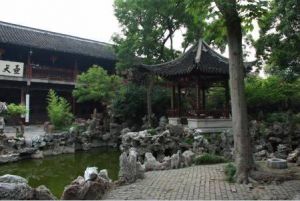Difference between revisions of "Geyuan Garden"
From Wiki China org cn
imported>Superleila m (Created page with ''''Geyuan''', on Dongguan Street in the eastern part of Yangzhou, was built by the salt tycoon Huang Yingtai in 1818. The site he chose was that of a Ming Dynasty des...') |
imported>Ciic |
||
| Line 1: | Line 1: | ||
| − | '''Geyuan''', on Dongguan Street in the eastern part of [[Yangzhou]], was built by the salt tycoon [[Huang Yingtai]] in 1818. The site he chose was that of a [[Ming Dynasty]] deserted garden—the [[Shouzhi Garden]]. The garden got its new name from the owner's sobriquet Geyuan. | + | '''Geyuan''' (个园), on Dongguan Street in the eastern part of [[Yangzhou]], was built by the salt tycoon [[Huang Yingtai]] in 1818. The site he chose was that of a [[Ming Dynasty]] deserted garden—the [[Shouzhi Garden]]. The garden got its new name from the owner's sobriquet Geyuan. |
The garden is known for its profuse bamboos and unique rockeries, which are sculpted and piled up to reflect the four seasons of a year, and are therefore known as the "Four Season Hills." | The garden is known for its profuse bamboos and unique rockeries, which are sculpted and piled up to reflect the four seasons of a year, and are therefore known as the "Four Season Hills." | ||
Latest revision as of 03:01, 3 June 2013
Geyuan (个园), on Dongguan Street in the eastern part of Yangzhou, was built by the salt tycoon Huang Yingtai in 1818. The site he chose was that of a Ming Dynasty deserted garden—the Shouzhi Garden. The garden got its new name from the owner's sobriquet Geyuan.
The garden is known for its profuse bamboos and unique rockeries, which are sculpted and piled up to reflect the four seasons of a year, and are therefore known as the "Four Season Hills."
